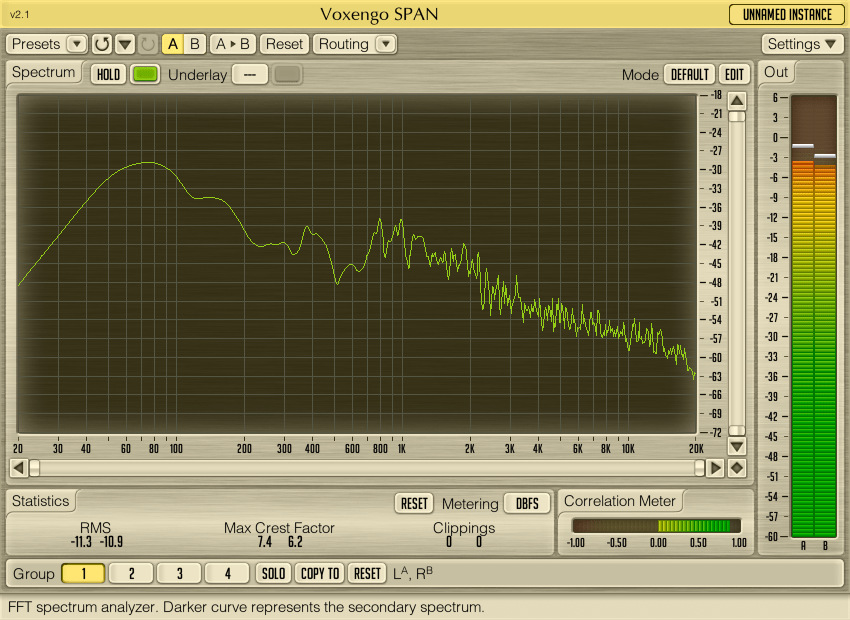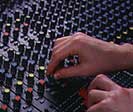| Author
|
eq and analyzer !!!
|
mikechedelic
IsraTrance Junior Member

Started Topics :
29
Posts :
104
Posted : Mar 2, 2011 07:53:52
|
when u cut a frequency and sweep it through the frequency spectrum ((check pics ))
how u you notice the ‘problem frequencies.?
i.e , u boost it a bit, and then in the eq
u sweep through it from 0 to 20k to listen and check the "bad" frecuencies !!
http://www.musicproductionnatural.com/Images/EQ%202.jpg

ps: images for illustrative purposes  !! !!
        +vibes!!! +vibes!!!
msn: mva360@hotmail.com |

|
|
orgytime
IsraTrance Full Member

Started Topics :
120
Posts :
1703
Posted : Mar 2, 2011 10:10
|
this has nothing to do with the analyzer, but your ears.
you are right you sweep with a high peak through the spectrum, listen carefulle for "ringing" frequencies (just those, what are ringing more than others) then notch the ringing frequency with a high Q setting.
if you got a better, more detailed analyzer (like free voxengo span), you also can see the critical feqeuencies... but this depends...

remember this kind of eqing needs much practice...
its hard to learn how much to take out, also always new ringing frequencies appear from cutting one out... also for much instruments, those ringing peaks are characteristic (sine waves for example), taking those out would kill the sound.        www.soundcloud.com/orgytime www.soundcloud.com/orgytime |

|
|
mikechedelic
IsraTrance Junior Member

Started Topics :
29
Posts :
104
Posted : Mar 2, 2011 10:11
|
i mean , when u see the analyzer, how u know whats ok and whats not ok !!!
cheers!!
        +vibes!!! +vibes!!!
msn: mva360@hotmail.com |

|
|
orgytime
IsraTrance Full Member

Started Topics :
120
Posts :
1703
Posted : Mar 2, 2011 10:14
|
Quote:
|
On 2011-03-02 10:11, mikechedelic wrote:
i mean , when u see the analyzer, how u know whats ok and whats not ok !!!
cheers!!
|
|
you dont... you should hear it... different waveforms etc have different high peaks.
the analyzer is more a help... simply listen to some pro tracks, put the analyzer on it, and check it...
        www.soundcloud.com/orgytime www.soundcloud.com/orgytime |

|
|
elastic_plastic
Re-Boot

Started Topics :
112
Posts :
1612
Posted : Mar 2, 2011 10:41
|
|
where could i find a nice analyzer vst? a freeware ofcourse |

|
|
orgytime
IsraTrance Full Member

Started Topics :
120
Posts :
1703
Posted : Mar 2, 2011 10:47
|
|
supergroover
IsraTrance Junior Member

Started Topics :
39
Posts :
1505
Posted : Mar 2, 2011 11:02
|
haha people read! both questions were already answered. And orgytime is right.
        soundcloud.com/supergroover soundcloud.com/supergroover |

|
|
PoM
IsraTrance Full Member

Started Topics :
162
Posts :
8087
Posted : Mar 2, 2011 14:14
|
when you listen to the sound if you dont hear any problems frequency don t try to find them with 12 db or more notchs, there is no point. if you need to boost a band 10 db to hear a problem i doubt it s really a problem.
my point is listen to the sound and listen to what you want to fix first, then when you visualise in your head the problems you might not even need to boost and swap frequencies but just cut what disturb you.
imo swaping frequency with a boost can be usefull to locate precisely a problem you can hear without any boost ,it s usefull to find it more easily. |

|
|
Freeflow
IsraTrance Full Member

Started Topics :
60
Posts :
3709
Posted : Mar 2, 2011 20:30
|
Just make the sound as loud as possible, if problems occur then its easy to notch them out.
But first the sound needs to be as loud as possible, this is where you first notice problems, if its not a frequency clash, then you notice it when two sounds play together and fight for same frequency space, I.e they both got strong volume there.
|

|
|
Locrian

Started Topics :
0
Posts :
24
Posted : Mar 2, 2011 22:51
|
Using an analyzer instead of your ears is bad craftsmanship and leads to worse sounding music.
There are two main issues to be aware of.
1. Not all analyzers display correct information and even if they do they all have a certain resolution and calibration(how long the sounds have to be to be detected and shown).
2. Humans doesn't hear sound exactly like it is. Bass frequencies for an example need to be a lot louder compared to 2-3kHz sounds to sound equally loud. Check out this for more details http://en.wikipedia.org/wiki/Fletcher%E2%80%93Munson_curves
An analyzer can be used as a complementary tool but it should never be the one you use to make decisions. That should be your ears.
        http://soundcloud.com/locrian/tracks http://soundcloud.com/locrian/tracks |

|
|
orgytime
IsraTrance Full Member

Started Topics :
120
Posts :
1703
Posted : Mar 2, 2011 23:07
|
Quote:
|
On 2011-03-02 22:51, Locrian wrote:
An analyzer can be used as a complementary tool but it should never be the one you use to make decisions. That should be your ears.
|
|
not exactly... for example, i have a hihat sample... i cant hear the subs in it... but i can see a minimal sub "carpet" on my eq.
that way i judge sometimes, its also nice to see how the spectrum reacts on EQ settings...
cheers
        www.soundcloud.com/orgytime www.soundcloud.com/orgytime |

|
|
Locrian

Started Topics :
0
Posts :
24
Posted : Mar 2, 2011 23:29
|
Quote:
|
On 2011-03-02 23:07, orgytime wrote:
Quote:
|
On 2011-03-02 22:51, Locrian wrote:
An analyzer can be used as a complementary tool but it should never be the one you use to make decisions. That should be your ears.
|
|
not exactly... for example, i have a hihat sample... i cant hear the subs in it... but i can see a minimal sub "carpet" on my eq.
that way i judge sometimes, its also nice to see how the spectrum reacts on EQ settings...
cheers
|
|
If you don't hear it I don't see much need for cutting them. The "subs" on hi-hats are just to low in volume(especially considering the low sensitivity to low pitched sound we have) to either interfere with other lows nor be heard.
But if it's something you worry about you can of course use the analyzer to find and cut them. But that's just a very limited example and one which I don't even see any real need to do.
As for thinking it's nice to see the changes... That is complementary use and nothing I oppose.
But pointing out one example where an analyzer "might" be needed doesn't really contradict that the main instrument should be your ears.
        http://soundcloud.com/locrian/tracks http://soundcloud.com/locrian/tracks |

|
|
Freeflow
IsraTrance Full Member

Started Topics :
60
Posts :
3709
Posted : Mar 3, 2011 03:21
|
volume is like a magnifier, you turn the volume up loud and you will hear. And there are percussion with subs loud enough to interfere with bass and kick, most of all they steal headroom. But this has more to do with what kind of sound you are after, and if you want precise and clear master. Basically you clean up sounds to get a clear sound picture.
Also it very much depend on if you make minimal music or very crowded. The analyzer is great fun to look at, also good if you are uncertain where to sweep. You see the area and you can work more precise. Its only a visual aid.
I use it to find where certain instruments recide and have most of their energy. But knowing which tone you work with will tell you this as well.
|

|
|
supergroover
IsraTrance Junior Member

Started Topics :
39
Posts :
1505
Posted : Mar 3, 2011 11:22
|
Quote:
|
If you don't hear it I don't see much need for cutting them. The "subs" on hi-hats are just to low in volume(especially considering the low sensitivity to low pitched sound we have) to either interfere with other lows nor be heard.
|
|
the more of these sounds you have the muddier your mix will be. So even if you can't really hear them the total of all these added sounds you can't hear will be muddying your mix. So it is better to cut them.
        soundcloud.com/supergroover soundcloud.com/supergroover |

|
|
monno
Grapes Of Wrath

Started Topics :
9
Posts :
454
Posted : Mar 3, 2011 20:52
|
Using an analyzer is a visual aid that can help you define trouble areas in case of doubt. Only used to double check. We make music for ears, not analyzers.
It can be useful in situations where limitations in acoustics and speakers prevent obtaining a true picture of what is going on across the entire frequency range. Besides that analyzers can have many different settings and not all of them correlate completely with what you hear. Different weightings and ballistics have a lot to say about the information available through such a tool and how it is interpreted.
Use only as a quick reference guide and use simple EQ sweeps to find the most offending freq´s if that is your aim.
+1 for Voxengo Span btw....surprisingly geeky for a free tool. I use it in combination with a hardware analyzer set to different weighting and ballistics (I find a combo is more useful, but i only use that when mastering, never in a mix situation)
        Mastering available here: Mastering available here:
http://www.bimmelim-soundlabs.com
http://soundcloud.com/onkeldunkel
http://www.myspace.com/onkeldunkelownz
http://www.parvati-records.com |

|
|